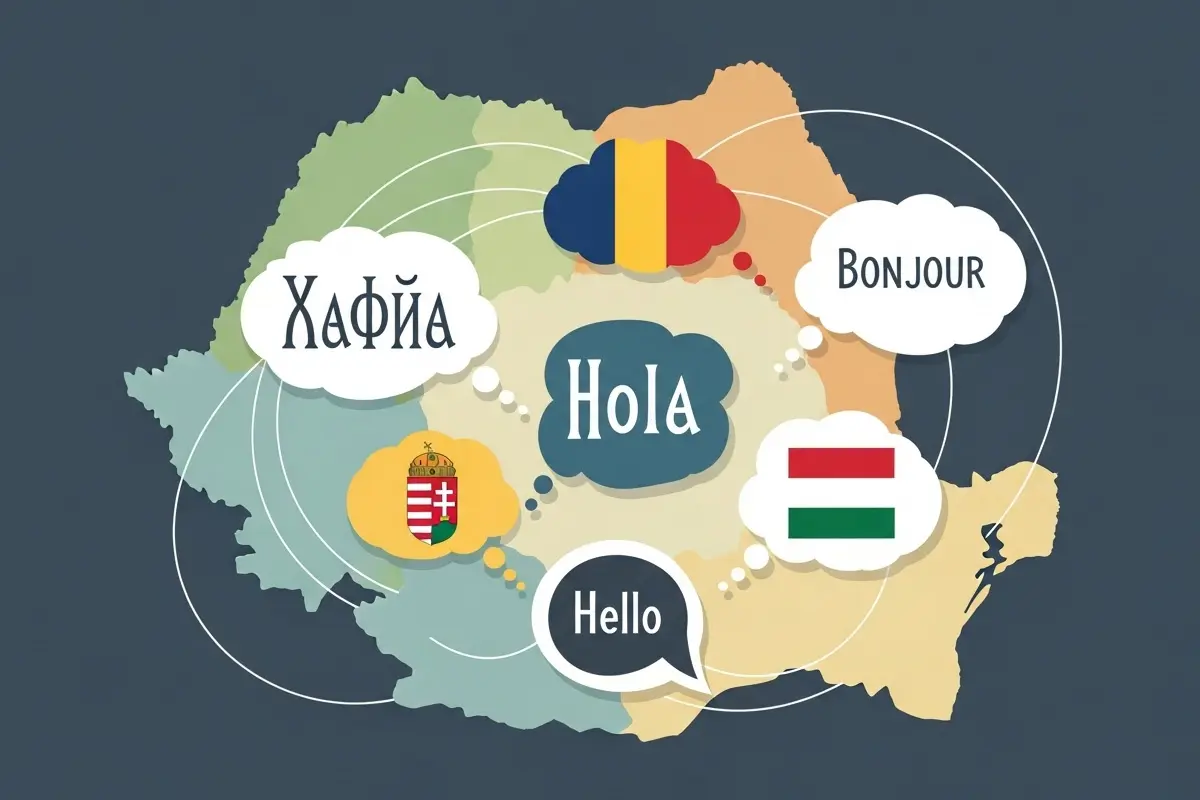
TL;DR
The official language of Romania is Romanian, a Romance language spoken by over 90% of the population. It shares roots with Italian, French, and Spanish, making it familiar for other Romance language learners. Alongside Romanian, minority languages like Hungarian, Romani, and German are also spoken, while English and French are common foreign languages, especially among young people and in urban areas.
Introduction: What Language Do They Speak in Romania?
If you’re asking what language do they speak in Romania, the straightforward answer is Romanian. Recognized as the official language in the Constitution, Romanian is used in schools, government, and daily life. However, the picture is more complex. Romania officially recognizes minority languages and regional dialects. It also has a strong tradition of learning foreign languages like English and French.
This article discusses Romanian as the official language. It also covers minority and foreign languages. Finally, it explains how this mix shapes Romania’s culture and identity.
Romanian: The Official Language
Romanian is a Romance language, part of the same family as Italian, French, Spanish, and Portuguese. It developed from Vulgar Latin introduced during Roman rule of ancient Dacia.
Key Facts About Romanian
- Speakers: Over 24 million worldwide, including neighboring Moldova.
- Alphabet: Latin script with special characters (ă, â, î, ș, ț).
- Grammar: Keeps Latin case system (nominative/accusative, genitive/dative, vocative).
- Vocabulary: Influenced by Slavic, Greek, Turkish, and Hungarian.
According to the Swedish Institute of Linguistics and Romanian sources, Romanian is spoken by about 90% of Romania’s population, making it the backbone of national communication.
Minority Languages in Romania
Romania’s multicultural history means many languages coexist with Romanian. The European Charter for Regional or Minority Languages guarantees linguistic rights for minority groups.
Major Minority Languages
- Hungarian – Spoken by about 6–7% of the population, especially in Transylvania. Hungarian schools, media, and signage are available in these areas.
- Romani – The language of the Roma community, preserved through cultural and educational initiatives.
- German – Spoken historically in Transylvania; today, smaller communities still use it in religious and cultural life.
- Ukrainian, Russian, Serbian, Bulgarian, Turkish, and Tatar – Present in border regions and coastal areas like Dobruja.
For example, in towns where minorities exceed 20% of the population, local administration allows official use of that minority language alongside Romanian (according to BBC Languages).
Dialects and Regional Variations
While Standard Romanian is widely understood, there are notable dialects:
- Wallachian (Muntenian) – Basis for Standard Romanian.
- Moldavian – Includes older Slavic influences, also spoken in Moldova.
- Transylvanian – Influenced by German and Hungarian contact.
- Banat – Contains Serbian loanwords.
Scholars debate whether related forms like Aromanian or Istro-Romanian are dialects or distinct languages.
Foreign Languages in Romania
Modern Romania is highly multilingual. Many Romanians, especially young people, speak at least one foreign language.
Most Commonly Spoken Foreign Languages
- English – The leading foreign language, especially in cities, universities, and tourism.
- French – Strong historical influence; Romania is a Francophone country.
- Italian and Spanish – Popular due to Romanian diaspora ties in Italy and Spain.
- German – Still important in schools, particularly in Transylvania.
According to Education.com, Romania’s education system promotes multilingual learning, ensuring students are proficient in Romanian, their native language, and at least one foreign language.
Romanian Compared to Other Languages
| Feature | Romanian | Italian / Spanish | Slavic Languages |
|---|---|---|---|
| Alphabet | Latin with diacritics | Latin | Cyrillic / Latin |
| Grammar | Retains cases | Cases mostly lost | Complex cases |
| Vocabulary | Romance roots + Slavic | Romance roots | Slavic roots |
| Mutual intelligibility | High with Italian/French | Very high | Low |
This makes Romanian unique: a Romance language in Eastern Europe, but with Slavic influences that set it apart from its Latin “cousins”.
Language Use in Daily Life
- Government & Administration: Romanian dominates official contexts.
- Education: Taught nationwide; minority languages available in schools where applicable.
- Media & Literature: Primarily Romanian, though minority-language outlets exist.
- Tourism: English is common in cities; basic Romanian phrases help in rural areas.
If you’re starting to learn, guides like our How to Say Good Morning in Romanian Language equivalent posts for Romanian greetings will give you confidence with polite phrases.
Challenges for Learners of Romanian
Romanian can feel easier for those familiar with Romance languages but presents challenges:
- Case system – Unlike French or Spanish, Romanian nouns change form depending on function.
- Vocabulary surprises – Slavic and Turkish loanwords may feel unfamiliar.
- Pronunciation – Sounds like ă and ț require practice.
Still, learners benefit from phonetic spelling and similarities with Italian and Spanish. As discussed in our guide on Romanian Language Basics: A Complete Guide, using structured strategies like immersion and media exposure applies equally well to Romanian.
FAQ: What Language Do They Speak in Romania?
Q: Is Romanian the only language spoken in Romania?
A: No. While Romanian is official, minority languages like Hungarian, Romani, and German are also spoken.
Q: Do Romanians speak English?
A: Yes. Especially among younger generations and in major cities.
Q: How similar is Romanian to Italian or Spanish?
A: Very similar in grammar and vocabulary, though Romanian retains unique Slavic and Balkan elements.
Conclusion
So, what language do they speak in Romania?
The clear answer is Romanian, but the full picture includes Hungarian, Romani, German, Ukrainian, and more. Romania’s embrace of multilingualism means visitors and learners will encounter not just one language, but a tapestry of influences reflecting the nation’s history and identity.
For learners, starting with Romanian basics provides cultural insight and practical communication skills, while minority and foreign languages add depth to understanding this diverse country.